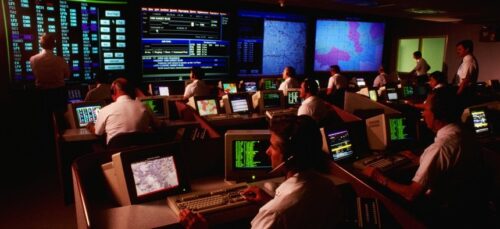
9.27.24 – Route Fifty
Call takers and dispatchers are working with technology from the 1980s, experts say. But there’s a possible solution.
It’s the stuff of nightmares: Your house is on fire, you’ve been in a major car accident or you’re being robbed. You call 911, and then you wait. And wait. And wait. The firefighters, paramedics or police officers don’t show up quickly because they were sent to the wrong place.
Nationwide, more than 600,000 calls are made to 911 a day. Of those hundreds of thousands of calls, the vast majority are answered and responded to in a timely manner. It’s rare for first responders to be sent to the wrong place, but it can happen. And some are worried it could happen more as dispatchers in 911 call centers battle with outdated technology that is prone to outages, as well as low staffing and maps that may not be up to date with the newest streets, buildings or other landmarks.
The July Crowdstrike debacle caused 911 outages in at least three states. Not long after that, the 911 call center in Washington, D.C., was knocked offline for hours because of a faulty software update. In fact, the district’s call center has come under fire repeatedly for outages, low staffing, outdated maps and more, which prompted Councilmember Brooke Pinto to introduce legislation pledging reform and greater oversight.
But experts say there’s a possible solution to these problems. The interplay of two technologies—FirstNet and Next Generation 911—could help bolster 911 dispatching and bring it up to date, they argue.. But it will take time, money and political support to make it a reality—even though there is broad agreement on the issues dispatchers face.
“I have the utmost respect for our 911 service individuals—the call takers, the dispatchers—but they are limited in what they can do by the technology that is in front of them,” Leonard Weiss, medical director for the Pittsburgh Department of Public Safety, said during a session at the recent International City/County Management Association’s annual conference in Pittsburgh. “Across the vast majority of America, the technology that is given to them is from the 1980s and it has really not advanced, and that’s not their fault.”
FirstNet offers one solution to the issues 911 dispatch centers face, according to experts. Established under federal legislation in 2012, the First Responder Network Authority gives public safety agencies their own interoperable broadband network in partnership with AT&T. It covers more than 2.97 million square miles across every state and territory, and was created after the Sept. 11, 2001, terrorist attacks highlighted shortcomings in emergency response communications networks.
More than 29,000 public safety agencies are now subscribed to FirstNet, and Seattle Assistant Fire Chief Chris Lombard said the technology has made 911 dispatchers’ lives in his city easier. Seattle has integrated FirstNet into its Emergency Services IP Network. That integration has allowed the city’s 911 call takers and dispatchers to route calls from anywhere, not just in their call centers, so they can operate from their homes or even from fire stations if the city needs to move out of one of its two 911 centers.
FirstNet’s dedicated network also will help with the implementation of several of Next Generation 911’s features, Lombard said, including the ability for call centers to receive photos and videos from the scene, and then send those images to police, fire and paramedics as well as staff in an emergency room.
It also enhances location services, meaning less confusion about where an incident has occurred, and can help staff more quickly identify and categorize the incident and the nature of the required response.
“Our teenagers can text video and message each other everywhere, but the overwhelming majority of your 911 centers across the country only get 911 calls by phone line,” Lombard said. “We’ve only just started in the last couple years to get most 911 centers to where they can receive text messages. We’re still 10 years behind what the smartphone is able to deliver.”
Next Generation 911 is an internet-based system, whereas traditional 911 relies on analog infrastructure. Many states are in the midst of transitioning to Next Generation 911, but it requires a lot more than upgraded technology. 911.gov, the agency responsible for the national 911 program, said states also must consider how their various agencies will collaborate, given that Next Generation 911 will make emergency response more interconnected.
But making the transition will be costly, especially given the fiscal pressures states are constantly under. Some have urged the federal government to step in and bear some of that cost.
In early September letters to both major presidential campaigns, the CEOs of the Association of Public-Safety Communications Officials International and the National Emergency Number Association urged them to “press for passage” of federal funding for Next Generation 911, “via any legislative vehicle.”
Congress last took up funding for the technology in May 2023 when the House Energy and Commerce Committee unanimously passed the Spectrum Auction Reauthorization Act, which included $15 billion for Next Generation 911.
The letter said the technology would provide call takers and dispatchers “with improved situational awareness, resulting in a faster and more efficient response for the members of the public they protect.” They added that the technology “will begin saving lives the moment it is implemented.” Next Generation 911 has been the center of a big lobbying push for many years, as associations and other groups advocate for federal funding to help localities upgrade their 911 systems.
Weiss, who is also medical director of the Allegheny County, Pennsylvania, 911 and Emergency Operations Center and an associate professor of emergency medicine at the University of Pittsburgh’s School of Medicine, said there are a lot of challenges ahead, but it has to be done.
“It’s just a matter of cost, access and infrastructure,” he said, “but what we will do here is give access to technology to help people.”
